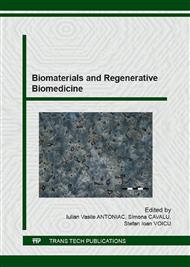[1]
D. Ítajner, N. MiliÇ, J. çanadanoviÇ-Brunet, A. Kapor, M. Ítajner, B.M. PopoviÇ, Exploring Allium species as a Source of Potential Medicinal Agents, Phytother. Res. 20 (2006) 581–584.
DOI: 10.1002/ptr.1917
Google Scholar
[2]
G. Griffiths, L. Trueman, T. Crowther, B. Thomas, B. Smith, Onions—A Global Benefit to Health, Phytother. Res. 16 (2002) 603–615.
DOI: 10.1002/ptr.1222
Google Scholar
[3]
K. Singh Bora, A. Sharmab, Phytoconstituents and Therapeutic Potential of Allium cepa Linn. – A Review, Phcog Rev. 3(5) (2009) 170-180.
Google Scholar
[4]
B. Darbyshire, B.T. Steer, Carbohydrate biochemistry. In: Rabinowitch HD, Brewster JL, eds. Onions and allied crops. Vol. III. Botany, physiology and genetics. Boca Raton, Florida: CRC Press Inc., 1990, p.1–16.
DOI: 10.1201/9781351075169
Google Scholar
[5]
M.W. Chase, J.L. Reveal, M.F. Fay, A subfamilial classification for the expanded asparagalean families Amaryllidaceae, Asparagaceae and Xanthorrhoeaceae, Botanical Journal of the Linnean Society. 161(2) (2009) 132–136.
DOI: 10.1111/j.1095-8339.2009.00999.x
Google Scholar
[6]
H.A. Suleria, M.S. Butt, F.M. Anjum, F. Saeed, N. Khalid, Onion: nature protection against physiological threats, Crit Rev Food Sci Nutr. 55(1) (2015) 50-66.
DOI: 10.1080/10408398.2011.646364
Google Scholar
[7]
Y. Morimitsu, S. Kawakishi, Inhibitors of platelet aggregation from onion, Phytochem. 29 (1990) 3435-3439.
DOI: 10.1016/0031-9422(90)85252-b
Google Scholar
[8]
M. Majewska-Wierzbicka, H. Czeczot, Flavonoids in the prevention and treatment of cardiovascular diseases, Pol Merkur Lekarski. 32(187) (2012) 50-54.
Google Scholar
[9]
H. Tapiero, D. Townsend, K. Tew, Organosulfur compounds from alliaceae in the prevention of human pathologies, Biomed Pharmacother. 58(3) (2004) 183–193.
DOI: 10.1016/j.biopha.2004.01.004
Google Scholar
[10]
Y. Morimitsu, Y.Y. Morioka, S Kawakishi, Inhibitors of platelet aggregation generated from mixtures of Allium species and/or s-alk(en)nyl-L-cysteine sulfoxides, J Ag Food Chem. 40 (1992) 368–372.
DOI: 10.1021/jf00015a002
Google Scholar
[11]
I.L. Goldman, M. Kopelberg, J.E.P. Debaene, B.S. Schwartz, Antiplatelet activity in onion (Allium cepa) is sulfur dependent, Thromb Haem. 76 (1996) 450–452.
DOI: 10.1055/s-0038-1650598
Google Scholar
[12]
R. Kubec, E. Dadáková, Chromatographic methods for determination of S-substituted cysteine derivatives - a comparative study, J Chromatogr A. 1216(41) (2009) 6957-6963.
DOI: 10.1016/j.chroma.2009.08.032
Google Scholar
[13]
G.G. Freeman, F. McBreen, Rapid spectrometry method of determination of thiosulfinate in onion (Allium cepa) and its significance in flavor studies, Biochem. Soc. Trans. 1 (1973) 1150-1152.
DOI: 10.1042/bst0011150
Google Scholar
[14]
K. Osmont, K. Arnt, I. Goldman, Temporal aspects of onion-induced antiplatelet activity, Plant Foods for Human Nutrition. 58 (2003) 27–40.
Google Scholar
[15]
E. Block, The organosulfur chemistry of the genus Allium-implications for the organic chemistry of sulfur, Agnew Chem Int Ed Engl. 31 (1992) 1135–1178.
DOI: 10.1002/anie.199211351
Google Scholar
[16]
N.E. Schmidt et al., Rapis extraction method of quantitating the lachrymatory factor of onion using gas chromatography, J. Agric. Food Chem. 44 (1996) 2690-2693.
DOI: 10.1021/jf950686s
Google Scholar
[17]
W.M. Randle, Book of Abstracts, 211th American Chemical Society National Meeting, New Orleans, L.A., (1996).
Google Scholar
[18]
K.R. Prince, M.J.C. Rhodes, Analysis of the major flavonol glucosides present in four varieties of onion (Allium cepa) and changes in composition resulting from autolysis, J Sci Food Agric. 74 (1997) 331-339.
DOI: 10.1002/(sici)1097-0010(199707)74:3<331::aid-jsfa806>3.0.co;2-c
Google Scholar
[19]
M. Jones, J. Hughes, A. Tregova, J. Milne, B. Tomsett, A. Hamish Collin, Biosynthesis of the flavour precursors of onion and garlic. Sulphur Metabolism in Plants Special Issue, Journal of Experimental Botany. 55(404) (2004) 1903–(1918).
DOI: 10.1093/jxb/erh138
Google Scholar
[20]
M. Ali, M. Thomson, M. Afzal, Garlic and onions: their effect on eicosanoid metabolism and its clinical relevance, Prost Leuk Essent Fatty Acids. 60 (2000) 43-47.
DOI: 10.1054/plef.1999.0124
Google Scholar
[21]
P.F. Cavagnaro, C.R. Galmarini: Effect of processing and cooking conditions on onion (Allium cepa L. ) induced antiplatelet activity and thiosulfinate content, J Agric Food Chem., 60(35) (2012) 8731-8737.
DOI: 10.1021/jf301793b
Google Scholar
[22]
W. Breu, W. Dorsch, Allium cepa L. (Onion): Chemistry, analysis and pharmacology. In: H. Wagner, N.R. Farnsworth, ed. Economic and Medicinal plants Research, London, Academic Press, 1994, 115-147.
Google Scholar
[23]
K.C. Srivastava, Onion exerts antiaggregatory effects by altering arachidonic acid metabolism in platelets, Prostaglandins Leukot Med. 24(1) (1986) 43-50.
DOI: 10.1016/0262-1746(86)90205-2
Google Scholar


